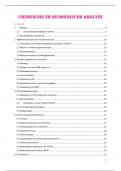Summary
Samenvatting Samenvattende nota's chemische en biomedische analyse
- Course
- Institution
Grondige nota's van het vak chemische en biomedische analyse onderwezen door professor Peter van Eenoo. Samenvatting gebaseerd op hoorcolleges, Powerpoint en boek. Geslaagd in eerste zit.
[Show more]



